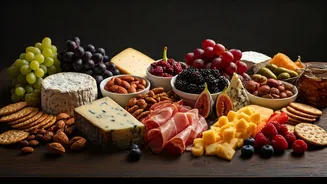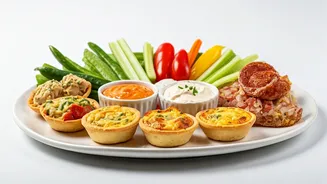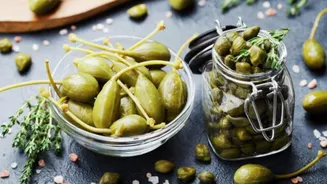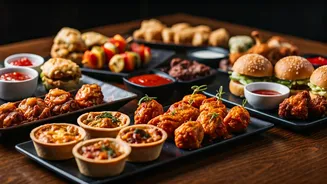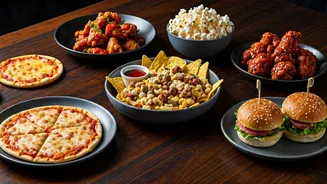Selecting Quality Ingredients
The foundation of a great charcuterie board begins with the quality of its components. Start by selecting a variety of cheeses, ranging in textures and
flavors. Include a mix of hard, soft, and semi-hard cheeses like cheddar, brie, and Gouda to offer diverse taste profiles. Next, choose an assortment of cured meats, such as prosciutto, salami, and chorizo, considering different spice levels and cuts. Don't underestimate the importance of accompaniments – include crackers, crusty bread, olives, nuts, and dried fruits. The best boards have ingredients that complement each other, with each element contributing something unique to the experience. High-quality ingredients are crucial, as they will define the overall taste and visual appeal.
Cheese and Meat Pairings
Pairing cheeses and meats strategically enhances the flavors and textures of your charcuterie board. Consider classic combinations that complement each other; for example, a creamy brie pairs perfectly with a salty prosciutto. Hard cheeses like aged cheddar are delicious with spicy salami. Experiment with different combinations to discover your favorites. Pay attention to balance: offer a mix of rich and light options, spicy and mild, and textures like crunchy nuts and smooth cheeses. Providing a range of pairings allows guests to sample different combinations and find their ideal taste profiles. When arranging, place complementary items near each other to guide guests.
Adding Fresh Produce
Fresh produce adds color, freshness, and a healthy touch to your charcuterie board. Include seasonal fruits and vegetables to enhance the board's visual appeal and taste. Grapes, berries, and sliced apples or pears provide sweetness and contrast. Vegetables like bell peppers, cucumbers, and cherry tomatoes add color and crunch. Consider adding a small bowl of olives, pickles, or marinated artichoke hearts for a tangy touch. Arrange the produce in a way that is aesthetically pleasing, such as creating small clusters or rows. Fresh produce brightens the board and provides a refreshing break from the richness of the cheese and meats. Plus, it provides guests with a lighter counterpoint to the heavier items on the board.
Incorporating Textures and Colors
To make your charcuterie board visually appealing, incorporate a variety of textures and colors. The contrast between different textures is important for an engaging experience. Think about mixing creamy cheeses with crispy crackers, crunchy nuts, and chewy dried fruits. Use a variety of colors to create visual interest. Include vibrant red tomatoes, green grapes, and purple berries. Arrange ingredients in an appealing way, using height and visual cues. Overlapping slices, fanning out meats, and creating different shapes using crackers and cheese can make the board more dynamic. A well-designed board isn’t just about taste, it's also about the sensory experience.
Spice Up Accompaniments
Elevating the accompaniments can significantly improve the overall charcuterie board. Instead of plain crackers, offer a selection of flavored options, such as rosemary crackers, sea salt crackers, or multigrain crisps. Include a variety of condiments that complement the cheese and meats. Honey, fig jam, or chutneys can enhance the flavors of the board and create delicious combinations. For those who like it spicy, add some hot pepper jelly or a small bowl of spicy mustard. Use small serving dishes and spoons for condiments to maintain a clean and elegant presentation. Providing guests with flavorful options and well-chosen additions takes a charcuterie board from good to exceptional.
Focus On Presentation
Presentation is a critical aspect of charcuterie board design. Start by choosing a suitable board, such as a wooden platter, a slate board, or a marble slab. Arrange the ingredients artfully, considering the colors, textures, and shapes. Don't overcrowd the board; ensure there is room for guests to access and enjoy the items. Use small bowls or ramekins to contain dips, spreads, and olives. Include serving utensils, such as cheese knives, spreaders, and small spoons, to help guests serve themselves. Garnishing with fresh herbs, such as rosemary or thyme, can enhance the visual appeal. Presentation transforms the board into a visual masterpiece that is inviting and accessible.
Personalizing the Board
Finally, personalize your charcuterie board to make it unique and tailored to the occasion or the preferences of your guests. Consider the theme of your event or the season. For the holidays, you could incorporate festive garnishes, such as fresh cranberries or sprigs of holly. If you know your guests' preferences, include their favorite cheeses, meats, and accompaniments. You can also add handmade items, such as spiced nuts or homemade crackers. Personalizing your board shows that you put thought and care into its creation. It makes the experience more engaging and enjoyable for everyone. A custom-made charcuterie board is a delightful way to show hospitality and create lasting memories.
